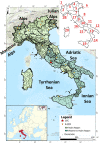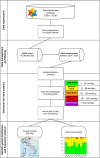Ten years of pluviometric analyses in Italy for civil protection purposes
- PMID: 34645910
- PMCID: PMC8514502
- DOI: 10.1038/s41598-021-99874-w
Ten years of pluviometric analyses in Italy for civil protection purposes
Abstract
The concept of climate change has grown in recent decades, influencing the scientific community to conduct research on meteorological parameters and their variabilities. Research on global warming, as well as on its possible economic and environmental consequences, has spread over the last 20 years. Diffused changes in trends have been stated by several authors throughout the world, with different developments observed depending on the continent. Following a period of approximately 40 days of almost continuous rain that occurred from October to November 2019 across the Italian territory and caused several hazards (e.g., floods and landslides), a relevant question for decision-makers and civil protection actors emerged regarding the relative frequencies of given rainfall events in the Warning Hazard Zones (WHZs) of Italy. The derived products of this work could answer this question for both weather and hydrogeological operators thanks to the frequency and spatio-temporal distribution analyses conducted on 10-year daily rainfall data over the entire Italian territory. This work aspires to be an additional tool used to analyse events that have occurred, providing further information for a better understanding of the probability of occurrence and distribution of future events.
© 2021. The Author(s).
Conflict of interest statement
The authors declare no competing interests.
Figures





References
-
- Helldén U, Tottrup C. Regional desertification: a global synthesis. Global Planet. Change. 2008;64:169–176. doi: 10.1016/j.gloplacha.2008.10.006. - DOI
-
- De Luca C, Furcolo P, Rossi F, Villani P, Vitolo C. Extreme rainfall in the Mediterranean. Science. 2010;2:19.
-
- Zhou X, Wang Y. Dynamics of land surface temperature in response to land-use/cover change. Geogr. Res. 2011;49:23–36. doi: 10.1111/j.1745-5871.2010.00686.x. - DOI
-
- Kiely, G, Albertson, JD, Parlange, MB. Recent trends in diurnal variation of precipitation at Valencia (1998).
LinkOut - more resources
Full Text Sources

